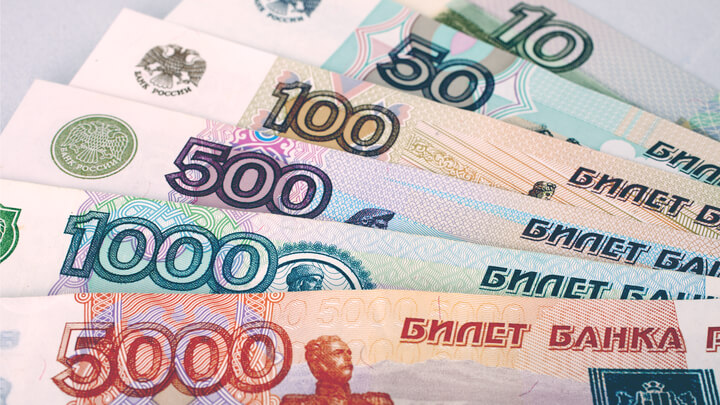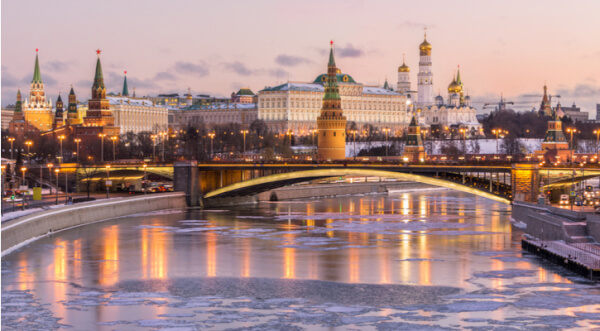ATMs in Russia: Credit cards and fees
Maybe you’re stopping by St Petersburg’s Hermitage Museum as part of a Baltic cruise, or perhaps you’re making the leap and moving to Moscow full time for...

After decades of being closed to many international visitors, Russia’s tourist industry has recently blossomed. In fact, Russia is one of the top ten most visited countries in the world. With 23 UNESCO World Heritage Sites, unique cultural heritage and attractions such as the iconic Trans-Siberian Railway, visitor numbers will likely continue to increase for years to come.
You may not be familiar with the currency or banking system in Russia - but if you’re planning a trip there, you’ll need to get up to speed.
This quick guide walks through the basics of Russia’s money, currency exchange systems and banks.
The official currency in Russia is the Rouble and, interestingly enough, was the world’s first decimalised currency way back in 1704.
| --- | --- |
| Rouble Symbols | RUB, ₽, руб |
| RUB Names | Can be written as ‘rubel’, ‘rouble, ‘copecks’ or ‘kopecks’ because Russia uses the cyrillic alphabet, and, therefore, has multiple transliterations for the same words. |
| 1 RUB | 1 rouble is divided into 100 kopeks |
| RUB coins | Coins used frequently include 10 and 50 kopek pieces (with 1 and 5 kopek pieces found occasionally) in addition to rouble coins of 1, 2, 5, 10 and sometimes 25. |
| RUB banknotes | Banknotes are issued in 5, 10, 50, 100, 500, 1000, and 5000 rouble denominations. The smaller notes aren’t used frequently, with people generally favouring the coins of the same size. |
It’s illegal to advertise prices in currencies other than roubles, although street vendors are often happy to accept payment in U.S. dollars or euros. It’s probably not a great idea, however, as you’ll find the exchange rates used are fairly poor. In addition, vendors rarely offer change in these circumstances. It’s a much better idea to shop in established stores and carry local currency to pay your way.
You can buy roubles in most major banks and currency exchange services in Europe and North America, although you might need to order in advance. Depending on the stability of the market, the rates may be better if you buy your cash at home rather than leaving it until you arrive in Russia. However, it pays to do some research in advance to make sure you can get the best deals.
If you need currency upon arrival, you can change a small amount at the airport - although the rates on offer are unlikely to be the best in town. Because exchange offices pay a premium to operate in airports, you can expect them to pass this mark up on to you as customer. The same applies for hotel exchange offices.
Although currency exchange desks in airports and hotels are often the worst of the bunch, you should watch out for hidden fees wherever you are.
Even if an exchange claims ‘Zero Commission’, they simply add in their profit to the poor exchange rate they offer you. Make sure you understand what you’re getting before you commit.
A good alternative can be using an ATM to withdraw your roubles directly, at a reasonable rate.
Before you choose a currency exchange service, make sure you understand the mid market rate for the currency you wish to exchange.
The mid market is the only real exchange rate, and should be used as a benchmark to compare the rates you’re offered. Find out the mid market rate by using a currency converter online before you decide which service to use.
If you are planning on exchanging cash in Russia, then take U.S. dollars or euros to exchange. Make sure the notes are clean and crisp, and only exchange them in a legitimate exchange office. Although you may be asked by street vendors if you want to change your money, this is technically illegal and almost certainly a very poor deal.
Traveller’s Cheques are not advised for visitors headed to Russia. They can’t be used to pay directly for goods, and exchanging them in a bank is subject to high fees. Add to this the inconvenience - only major bank branches may exchange your Cheques for cash - and they’re really not worthwhile.
If you already have Cheques and are left with no choice, then Sberbank - Russia’s state bank - will exchange them for you for a fee.
Consider using your credit or debit card, instead.
Although larger businesses in Russia, and especially in tourist areas, will accept credit and debit cards, you will find many exceptions. Not all businesses accept cards, so carrying cash is a good idea. If you need cash in a hurry, use one of the ATM locators in the next section to find a nearby bank machine and withdraw some cash directly.
If you’re intending on using your cards abroad, it’s worth telling your bank you’ll be travelling. Although the policies of individual banks vary, it’s not uncommon for purchases in Russia to be viewed as ‘suspicious’ by your bank’s anti-fraud software. If this happens, you might find that your card is limited or blocked altogether. Much better to let them know in advance that you will be travelling in the region.
If you’re using a credit or debit card abroad, you might be asked if you want to be charged in your home currency - this is called Dynamic Currency Conversion (DCC).
DCC is listed as a ‘service’, offering customers the ability to see the cost of the transactions in their home currency. Unfortunately, though, it’s not really a benefit for travellers. Accepting this option allows the foreign ATM, rather than your home bank, to choose an exchange rate for you (almost always a very poor one) and may also cost you additional fees. Opt to pay in the local currency (RUB) at the foreign ATM, instead.
There are good ATM networks in Russia in and near banks as well as in shopping malls and tourist areas. Try one of the locator tools below to find an ATM near you:
Visa ATM locator
MasterCard ATM locator
Amex ATM locator
When making a withdrawal abroad, you will be charged fees by both your home banks and, often, by the ATM operator too. Nonetheless, this can be an economical option because the exchange rate applied by your home banks is usually one of the more fair.
Check the fees you will be charged by your home bank before you leave. Many ATMs in Russia have relatively low limits on withdrawals, which might mean you have to make several withdrawals at once. If your bank charges per withdrawal this can mount up quickly.
Watch out for DCC (in the previous section). This is as bad an idea when withdrawing cash as it is when paying for goods and services on your card. If you choose to be charged in your home currency then you won’t be given your home bank’s exchange rate, but one assigned by the foreign ATM. Always select to be charged in local currency, instead.
The largest banks in Russia are homegrown operations, which have subsequently expanded across parts of Europe. However, some Western European banks also operate within Russia, with branches in major cities.
Sberbank, which is effectively the state bank of Russia, is the largest retail bank by quite a margin. Sberbank operates across Russia, but also in the Eastern European region, under their own name and that of subsidiaries. In fact, Sberbank boasts 11 million customers outside of Russia’s borders.
With many banks working across the region, it’s definitely worth checking if your home bank has a partnership with a local Russian bank. If they do, you may be able to withdraw cash from some ATMs for lowered fees.
Alternatively, for simple access to your money abroad - and an even better deal - use Wise.
If you have a bank account in Russia, or know someone who does, you can transfer money between countries using the real mid-market exchange rate. It's a convenient way to have your cash waiting for you, with no hidden fees.
*Please see terms of use and product availability for your region or visit Wise fees and pricing for the most up to date pricing and fee information.
This publication is provided for general information purposes and does not constitute legal, tax or other professional advice from Wise Payments Limited or its subsidiaries and its affiliates, and it is not intended as a substitute for obtaining advice from a financial advisor or any other professional.
We make no representations, warranties or guarantees, whether expressed or implied, that the content in the publication is accurate, complete or up to date.

Maybe you’re stopping by St Petersburg’s Hermitage Museum as part of a Baltic cruise, or perhaps you’re making the leap and moving to Moscow full time for...

As Russia’s capital and largest city, Moscow sees an enormous amount of visitors each year. Many come as tourists, but a little over a third travel for...